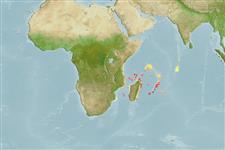>
Centrarchiformes (Basses) >
Kuhliidae (Aholeholes)
Etymology: Kuhlia: Because of Heindrich Kuhl, 1797-1821; researcher also with lizards (Gekkonidae).
More on author: Lacepède.
Environment: milieu / climate zone / depth range / distribution range
Ökologie
seewasser; süßwasser; brackwasser benthopelagisch. Tropical (Ref. 6799)
Africa: probably known only from Reunion, Mauritius, Rodriguez and Madagascar (Ref. 57749).
Size / Gewicht / Alter
Maturity: Lm ? range ? - ? cm
Max length : 25.0 cm TL Männchen/unbestimmt; (Ref. 6799)
Kurzbeschreibung
Morphologie | Morphometrie
Rückenflossenstacheln (insgesamt): 10; Rückenflossenweichstrahlen (insgesamt): 11-14; Afterflossenstacheln 3; Afterflossenweichstrahlen: 11 - 13. Oval and high body, laterally compressed and elongated. Lower jaws proeminent. Large protusible and superior mouth. Opercle shows two spines. Dorsal fin starts at the same level than the pelvics. Silvery body with a darker blue to greyish back. Caudal forked with two vertical stripes. First at the base of the caudal and second is the posterior margin of the fin. In between these two stripes is a white stripe. K. splendens Regan, 1913 might be a synonym of that species (Stapley pers. com.).
Life cycle and mating behavior
Geschlechtsreife | Fortpflanzung | Ablaichen | Eier | Fecundity | Larven
Keith, P., G. Marquet, P. Valade, P. Bosc and E. Vigneux, 2006. Atlas des poissons et des crustacés d'eau douce des Comores, Mascareignes et Seychelles. Muséum national d’Histoire naturelle, Paris. Patrimoines naturels, 65:250p. (Ref. 57749)
IUCN Rote Liste Status (Ref. 130435)
Bedrohung für Menschen
Harmless
Nutzung durch Menschen
Mehr Information
NamenSynonymeMetabolismusRäuberÖkotoxikologieFortpflanzungGeschlechtsreifeAblaichenSpawning aggregationFecundityEierEientwicklung
Alter/GrößeWachstumLänge-GewichtLänge-LängeLängenhäufigkeitenMorphometrieMorphologieLarvenLarven Pop.Dyn.RekrutierungDichteBRUVS
ReferenzenAquakulturAquakultur ProfilZuchtlinienGenetikElectrophoresesVererbbarkeitKrankheitenVerarbeitungNutrientsMass conversion
PartnerBilderStamps, Coins Misc.LauteCiguateraGeschwindigkeitSchwimmstilKiemenoberflächeOtolithsGehirngrößeSehfähigkeit
Tools
Zusatzinformationen
Download XML
Internet Quellen
Estimates based on models
Preferred temperature (Ref.
123201): 25.4 - 28, mean 27.2 °C (based on 153 cells).
Phylogenetic diversity index (Ref.
82804): PD
50 = 0.5002 [Uniqueness, from 0.5 = low to 2.0 = high].
Bayesian length-weight: a=0.01413 (0.00591 - 0.03375), b=3.06 (2.86 - 3.26), in cm total length, based on LWR estimates for this (Sub)family-body shape (Ref.
93245).
Trophic level (Ref.
69278): 3.4 ±0.5 se; based on size and trophs of closest relatives
Widerstandsfähigkeit (Ref.
120179): mittel, Verdopplung der Population dauert 1,4 - 4,4 Jahre. (Preliminary K or Fecundity.).
Fishing Vulnerability (Ref.
59153): Low vulnerability (15 of 100).
